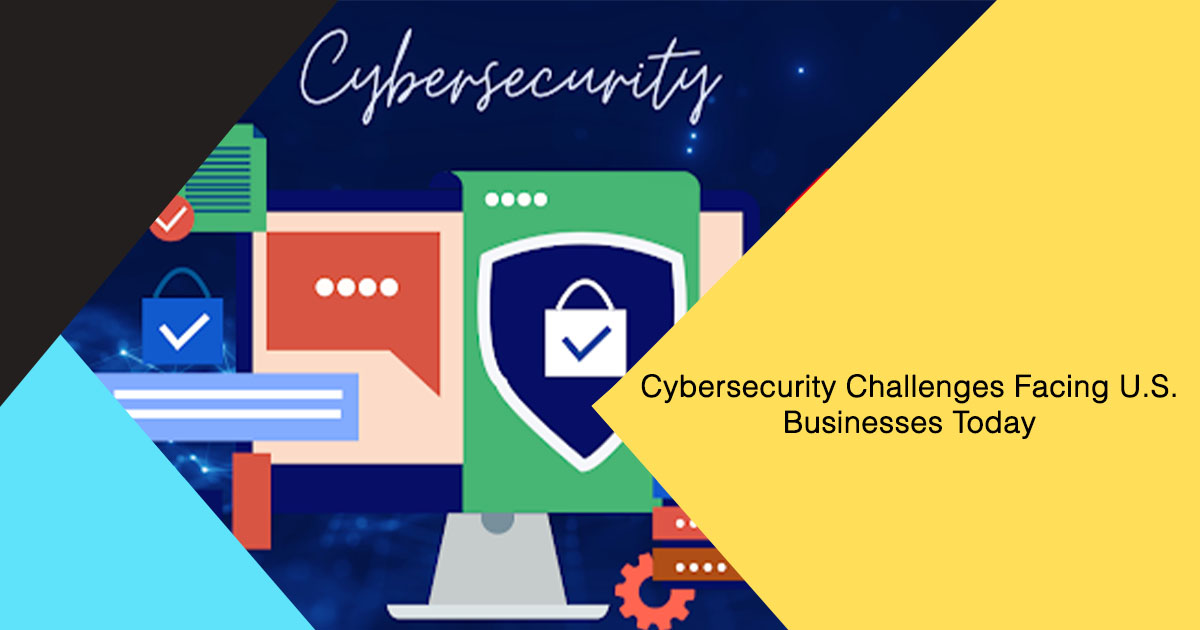Cybersecurity Challenges Facing U.S. Businesses Today

Cybersecurity is a critical concern for U.S. businesses in an increasingly digital world. With the rise in sophisticated cyberattacks and growing regulatory pressures, companies must navigate a challenging landscape to protect their data, operations, and reputation. Here are the key cybersecurity challenges U.S. businesses face today:
1. Ransomware Attacks
- What It Is: Ransomware encrypts a victim's data, demanding payment for decryption. These attacks can disrupt business operations and lead to significant financial losses.
- Why It’s a Problem: Ransomware attacks have grown in complexity and frequency, targeting small businesses, large enterprises, and critical infrastructure. Many organizations struggle to recover even after paying ransoms.
- High-Profile Cases: The Colonial Pipeline attack in 2021 showcased how ransomware can cripple vital services and lead to widespread consequences.
2. Phishing and Social Engineering
- What It Is: Cybercriminals use deceptive emails, messages, or calls to trick employees into revealing sensitive information or granting system access.
- Why It’s a Problem: Despite awareness training, phishing remains one of the most common attack vectors, exploiting human error rather than technical vulnerabilities.
- Impact: Stolen credentials can lead to broader breaches, including unauthorized access to sensitive systems or financial fraud.
3. Supply Chain Vulnerabilities
- What It Is: Cyberattacks targeting third-party vendors, suppliers, or software providers to exploit weaknesses and gain access to larger networks.
- Why It’s a Problem: Even well-protected organizations are vulnerable if their suppliers have inadequate security. The SolarWinds attack demonstrated the dangers of compromised supply chains.
- Mitigation Challenges: Managing and securing third-party relationships is complex, especially as supply chains grow increasingly global and interconnected.
4. Insider Threats
- What It Is: Malicious or negligent actions by employees, contractors, or business partners that lead to data breaches or system compromises.
- Why It’s a Problem: Insiders often have authorized access to sensitive data, making it difficult to detect and prevent these threats.
- Common Examples: Unintentional errors, such as misconfiguring databases, or deliberate actions like data theft for financial gain.
5. Advanced Persistent Threats (APTs)
- What It Is: Sophisticated, long-term cyberattacks often orchestrated by nation-states or well-funded cybercriminal organizations targeting specific industries or companies.
- Why It’s a Problem: APTs are stealthy, persistent, and tailored, making them difficult to detect and mitigate. They often focus on stealing intellectual property or disrupting critical operations.
- Targets: High-value sectors like defense, healthcare, and financial services are common targets.
6. Emerging Technologies and IoT Vulnerabilities
- What It Is: As businesses adopt new technologies like IoT, AI, and 5G, they introduce new security risks and attack surfaces.
- Why It’s a Problem: Many IoT devices lack robust security protocols, making them easy entry points for cybercriminals.
- Examples: Unsecured smart devices, like cameras or sensors, can be exploited for network access or as part of botnet attacks (e.g., Mirai).
7. Data Breaches and Privacy Violations
- What It Is: Unauthorized access to sensitive customer or business data that can lead to identity theft, financial fraud, and regulatory penalties.
- Why It’s a Problem: Data breaches damage trust and carry significant financial and reputational costs.
- Regulatory Pressure: Laws like GDPR, CCPA, and other state-specific regulations impose stringent requirements on data protection, increasing the stakes for compliance failures.
8. Cloud Security Challenges
- What It Is: As businesses migrate to cloud platforms, they face challenges in securing data stored and processed off-premises.
- Why It’s a Problem: Misconfigured cloud settings, inadequate encryption, and shared responsibility models can leave gaps in security.
- Risks: Cloud misconfigurations have led to major data exposures, with attackers exploiting improperly secured storage systems.
9. Workforce Gaps in Cybersecurity
- What It Is: A shortage of skilled cybersecurity professionals to manage and respond to threats.
- Why It’s a Problem: Many businesses lack the expertise needed to implement robust security measures, leaving them vulnerable.
- Numbers: According to industry estimates, the U.S. has a significant cybersecurity workforce shortage, with hundreds of thousands of unfilled positions.
10. Remote Work Security Risks
- What It Is: The shift to remote work has expanded attack surfaces, with employees accessing corporate systems from home networks and personal devices.
- Why It’s a Problem: Remote work environments are often less secure, making them attractive targets for cybercriminals.
- Common Risks: Use of unsecured Wi-Fi, weak passwords, and outdated software increases the likelihood of breaches.
11. Regulatory Compliance Challenges
- What It Is: Businesses must navigate complex and evolving cybersecurity and data privacy regulations.
- Why It’s a Problem: Non-compliance can lead to heavy fines, legal actions, and reputational damage.
- Examples: U.S. regulations like the Cybersecurity Maturity Model Certification (CMMC) for defense contractors and state-specific laws like New York’s SHIELD Act.
12. Cyber Insurance Limitations
- What It Is: Businesses rely on cyber insurance to mitigate financial losses, but coverage is becoming more restrictive.
- Why It’s a Problem: Insurers are raising premiums, limiting payouts, and excluding certain risks, leaving businesses with coverage gaps.
- Implications: Without adequate coverage, businesses may struggle to recover from financial impacts of major breaches.
13. Sophistication of Threat Actors
- What It Is: Cybercriminals are using more advanced tactics, leveraging AI, machine learning, and automation to launch targeted and scalable attacks.
- Why It’s a Problem: Traditional defenses like firewalls and antivirus software are often insufficient against evolving threats, requiring businesses to adopt more advanced detection and response systems.
14. DDoS (Distributed Denial of Service) Attacks
- What It Is: Flooding a system with traffic to overwhelm it and disrupt operations.
- Why It’s a Problem: DDoS attacks can paralyze business websites, e-commerce platforms, and critical systems, leading to downtime and financial loss.
- Trends: Attacks are becoming larger in scale and harder to mitigate without specialized tools.
Solutions and Strategies
- Adopt Zero Trust Architecture: Enforce strict access controls, continuously verify identities, and limit users to the minimum access required for their roles.
- Invest in Employee Training: Equip employees with the knowledge to recognize phishing attempts, use strong passwords, and follow security best practices.
- Enhance Endpoint Security: Deploy tools like EDR (Endpoint Detection and Response) to protect devices used for remote work.
- Leverage AI and Automation: Use AI-driven tools to detect and respond to threats in real-time, reducing response times and human error.
- Regular Security Audits: Conduct regular penetration testing and vulnerability assessments to identify and address weaknesses.
- Implement Multi-Factor Authentication (MFA): Add layers of security to access systems and sensitive data.
- Collaborate with Third-Party Experts: Partner with managed security service providers (MSSPs) for monitoring and threat management.
- Backup and Disaster Recovery Plans: Maintain regular, secure backups and test recovery plans to ensure quick restoration after attacks.
Conclusion
U.S. businesses face a constantly evolving landscape of cybersecurity challenges, with attackers becoming more sophisticated and attack surfaces expanding. Addressing these challenges requires a proactive approach, combining advanced technology, employee training, regulatory compliance, and robust incident response strategies. By prioritizing cybersecurity as a core business function, companies can protect their operations, reputation, and customer trust in an increasingly interconnected world.










